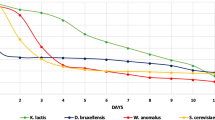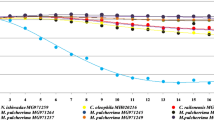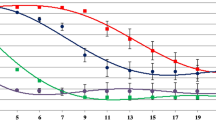Abstract
The aroma formation in the fermentation of two types of natural musts by 12 different yeasts has been analysed. In grape must fermentation Pichia fermentans Colección Española de Cultivos Tipo (CECT) 11773, Clavispora lusitaniae OJ6 and Pichia anomala OJ5 produced the best balance between concentrations of ethyl acetate and high alcohols. When orange juice was fermented with the 12 yeasts, Pichia fermentans CECT 11773, Rhodotorula mucilaginosa OJ2 and Hanseniaspora uvarum CECT 10885 produced a good beverage with low alcoholic grade. For both types of natural musts Pichia fermentans CECT 11773 increased the presence of higher alcohols and ethyl acetate. After using this strain both alcoholic beverages obtained the highest evaluation in the sensory analysis.
Similar content being viewed by others
References
Arias, C.R., Burns, J.K., Friedrich, L.M., Goodrich, R.M. & Parish, M.E. 2002 Yeast species associated with orange juice: evaluation of different identification methods. Applied and Environmental Microbiology 68, 1955–1961.
Arlorio, M., Coïsson, J.D. & Martelli, A. 1999 Identification of Saccharomyces cerevisiae in bakery products by PCR amplification of the ITS region of ribosomal DNA. European Food Research Technology 209, 185–191.
Avakyants, S.P., Rastyannikov, E.G., Chernayaga, B.S. & Navrotskii, V.J. 1981 Dhromato-mass-spektrometricheskoe issledovanie letuchikh vesnchestv vina. Vino del Vinograd 41, 50–53.
Ciani, M. & Maccarelli, F. 1998 Oenological properties of non-Saccharomyces yeasts associated with wine-making. World Journal of Microbiology and Biotechnology 14, 199–203.
Gil, J.V., Mateo, J.J., Jiménez, M., Pastor, A. & Huerta, T. 1996 Aroma compounds in wine as influenced by apiculate yeasts. Journal of Food Science 61, 1247–1249.
Kourkoutas, Y., Koutinas, A.A., Kanallaki, M., Banat, I.M. & Marchant, R. 2002 Continuous wine fermentation using a psychrophilic yeast immobilized on apple cuts at different temperatures. Food Microbiology 19, 127–134.
Las Heras-Vázquez, F.J., Mingorance-Cazorla, L., Clemente-Jiménez, J.M. & Rodríguez-Vico, F. 2003 Identification of yeast species from orange fruit and juice by RFLP and sequence analysis of the 5.8S rRNA gene and internal transcribed spacers. FEMS Yeast Research (accepted to publish FEMSYR reference 1053, Editorial reference: FEMSYR-069).
Lema, C., García-Jares, C., Orriols, I. & Angulo, L. 1996 Contribution of Saccharomyces and non-Saccharomyces populations to the production of some components of Albariño winte aroma. American Journal of Enology and Viticulture 47, 206–216.
Lilly, M., Lambrechts, M.G. & Pretorius I.S. 2000 Effect of increased yeast alcohol acetyltransferase activity on flavor profiles of wine and distillates. Applied and Environmental Microbiology 66, 744–753.
Mateo, J.J., Jiménez, M., Huerta, T. & Pastor, A. 1991 Contribution of different yeasts isolated from musts of monastrell grapes to the aroma of wine. International Journal of Food Microbiology 14, 153–160.
Mingorance-Cazorla, L., Molina-Ruiz J.M., Clemente-Jiménez J.M., Las Heras-Vázquez, F.J. & Rodríguez-Vico, F. 1999 Procedimiento para la obtención de un producto derivado del zumo de naranja que implica la modificación de su composición química por un proceso de fermentación dirigida y natural mediante el empleo de levaduras alcoholeras. Patente Española No. 9902315.
Rapp, A. & Mandery, H. 1986 Wine aroma. Experientia 42, 873–884.
Rojas, V., Gil, J.V., Piñaga, F. & Manzanares, P. 2001 Studies on acetate ester production by non-Saccharomyces wine yeasts. International Journal of Food Microbiology 70, 283–289.
Romano, P. & Suzzi, G. 1993 Acetoin production in Saccharomyces cerevisiae wine yeasts. FEMS Microbiology Letters 108, 23–26.
Romano, P. & Suzzi, G. 1996 Origin and production of acetoin during wine yeast fermentation. Applied and Environmental Microbiology 62, 309–315.
Romano, P., Suzzi, G., Comi G. & Zironi R. 1992 Higher alcohol and acetic acid production by apiculate wine yeasts. Journal of Applied Bacteriology 73, 126–130.
Romano, P., Suzzi, G., Comi, G., Zironi, R. & Maifreni, M. 1997a Glycerol and other fermentation products of apiculate wine yeasts. Journal of Applied Microbiology 82, 615–618.
Romano, P., Suzzi, G., Domizio, P. & Fatichenti, F. 1997b Secondary products formation as a tool for discriminating non-Saccharomyces wine strains. Antonie van Leeuwenhoek 71, 239–242.
Sipiczki, M., Romano, P., Lipani, G., Miklos, I. & Antunovics, Z. 2001 Analysis of yeasts derived from natural fermentation in a Tokaj winery. Antonie van Leeuwenhoek 79, 97–105.
Suárez-Lepe, J.A. 1997 Levaduras vínicas. Funcionalidad y uso en bodega. pp. 121-149. Mundi-Prensa Eds. ISBN 84-7114-685-1.
Suomalainen, H. 1971 Yeast and its effect on the flavour of alcoholic beverages. Journal of the Institute of Brewing 77, 164–177.
Toro, M.E. & Vázquez, F. 2001 Fermentation behaviour of controlled mixed and sequential cultures of Candida cantarellii andSaccharomyces cerevisiae wine yeasts. World Journal of Microbiology and Biotechnology 18, 347–354.
Ubeda-Iranzo, J.F., González-Magaña, F. & González-Viñas, M.A. 2000 Evaluation of the formation of volatiles and sensory characteristics in the industrial production of white wines using different commercial strains of the genus Saccharomyces. Food Control 11, 143–147.
van der Aa Kühle, A. & Jespersen, L. 1998 Detection and identification of wild yeasts in lager breweries. International Journal of Food Microbiology 43, 205–213.
Zironi, R., Romano, P., Suzzi, G., Battistutta, F. & Comi, G. 1993 Volatile metabolites produced in wine by mixed and sequential cultures of Hanseniaspora guilliermondii or Kloeckera apiculata and Saccharomyces cerevisiae. Biotechnology Letters 15, 235–238.
Zoecklein, B.W., Fugelsang, K.C., Gump, B.H. & Nury, F.S. 2001 Análisis y producción de vino. ed. Acribia, S.A. pp. 101-119. ISBN 87-200-0936-9.
Author information
Authors and Affiliations
Rights and permissions
About this article
Cite this article
Mingorance-Cazorla, L., Clemente-Jiménez, J., Martínez-Rodríguez, S. et al. Contribution of different natural yeasts to the aroma of two alcoholic beverages. World Journal of Microbiology and Biotechnology 19, 297–304 (2003). https://doi.org/10.1023/A:1023662409828
Issue Date:
DOI: https://doi.org/10.1023/A:1023662409828




